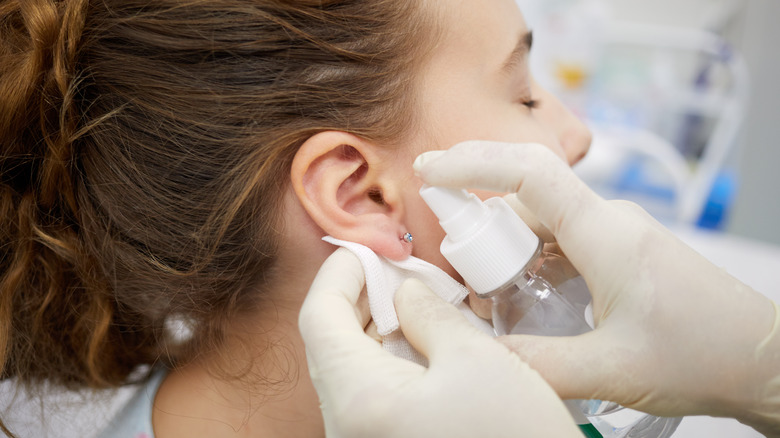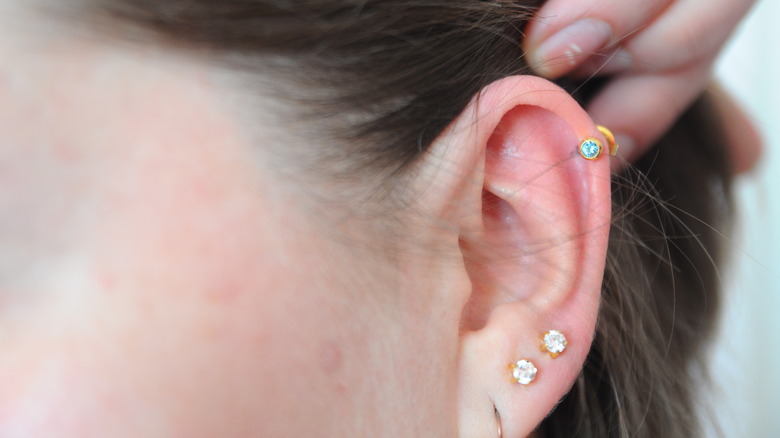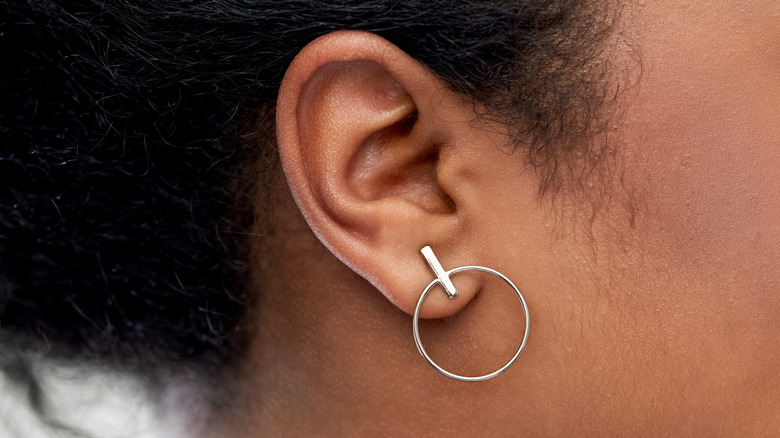What To Do If Your Ear Piercing Becomes Infected
Just like soft pretzels and Victoria's Secret, chances are you'll bump into a store that offers ear piercing while at the mall. However, before you walk into Claire's, think twice. It's far more likely that a shopping mall piercing will get infected. According to Marine Agency Insurance, mall kiosks use piercing guns that are hard to disinfect to puncture the lobe quickly, while a professional studio will usually opt for a hollow needle. The Association of Professional Piercers does not allow the use of piercing guns due to safety and hygiene concerns. In fact, APP argues that using disposable needles is the only sterile piercing method (via Bustle).
It's also worth noting that experts use sharpened tools for a cleaner piercing experience. However, a business like Claire's may rely on blunt earring studs to create holes, causing damage to the tissue surrounding the new opening. According to professional piercer Brian Keith Thompson, "So, [a piercing gun] is actually tearing through your ear and not cutting through your ear, like the needle [does]." Ultimately, it's probably wise to book an appointment at a specialized studio rather than risk infection at a mall, even if Claire's is much cheaper (and easy to visit on the way to Macy's).
If you've already opted for that mall piercing, however, there are ways to combat early signs of infection. According to Mayo Clinic, earlobe infections can usually be treated from the comfort of your own home in just a few days. That is unless the hard tissue surrounding your ear, known as the cartilage, becomes infected. This type of inflammation may need to be treated by a professional.
Don't take out your earring
After your piercing becomes irritated — this may involve redness, swelling, and small amounts of discharge, among other symptoms — it's time to take matters into your own (thoroughly washed) hands. Though it might seem like a natural next step, don't remove the jewelry. This can trap the infection and cause bacteria to spread. Start by cleansing the swollen area with salt water. Healthline recommends mixing ¼ tsp salt and 8 ounces of distilled water, a simple kitchen concoction that will kill harmful bacteria. Over-the-counter saline solutions can also be used to clean the wound. You may have even received a complimentary bottle of saline after your piercing appointment. If not, check the aisles of your local pharmacy or search online.
Healthline advises against applying saline with tissues or cotton balls, explaining that their fibers can easily get trapped around the earring. Dry the area with gauze, per Mayo Clinic, and apply a topical antibiotic ointment like Neosporin. With clean hands, gently turn the stud around several times to make sure it doesn't stick to your ear, trapping bacteria.
Until the swelling calms down, repeat these steps three times a day. Sometimes, a small lump made up of trapped fluids can form around a new piercing. If you notice one of these lumps, known medically as granulomas, treat the area with a warm compress (via NHS). If the infection worsens, visit your doctor to receive a prescription for oral antibiotics.
Earlobe piercings can take up to two months to fully heal
The most popular piercing location is the earlobe, an area that can take up to two months to heal post-appointment (via Mezi). During these healing months, it's important to keep the original jewelry clasped in place. This will prevent the hole from closing up. In other words, even if it's tempting to start wearing stylish jewelry, hold off until the wound is fully healed. According to WebMD, cartilage piercings can take a full year to heal.
It's also key to note any possible metal sensitivities to prevent future irritation. Titanium, 14-karat gold, or surgical-grade stainless steel are great options — really, any hypoallergenic metals are preferable for piercings. While expensive, platinum also works well in newly-pierced ears. "Platinum is safe for first piercings [because] it's inert and hypoallergenic. It's good [as an alternative] when people have skin allergies to silver and gold," board-certified dermatologist Dr. Morgan Rabach tells Byrdie. Metals like nickel, cobalt, and white gold are more likely to result in allergic reactions, according to HuffPost.
The bottom line? A lot happens to your body post-piercing. It's important to note that body modification, just like any wound, is trauma, albeit minor. Just as you would care for a scraped knee or stovetop burn, keep a watchful eye on your ear until it's fully healed.


